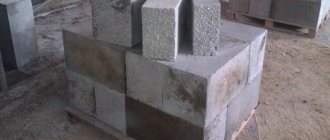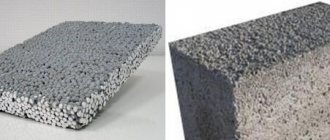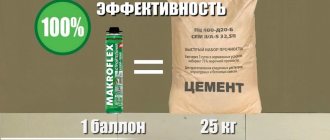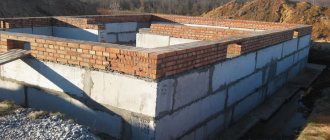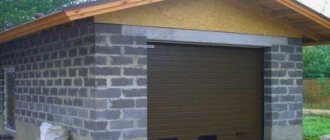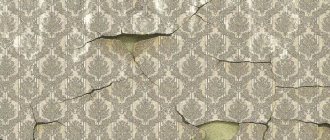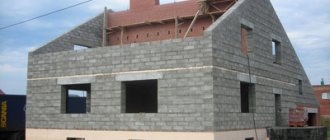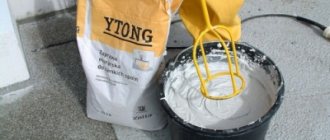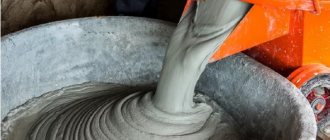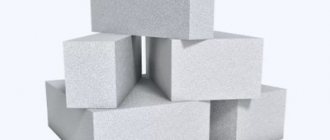The simplest method of masonry for a private house (cottage) with 1-3 floors is in rows, used for a single-row dressing system. Laying of each subsequent row begins upon completion of the previous one.
Standard blocks of the D400 and D500 brands are produced in three types of sizes: 588x300x188, 588x380x188, 588x380x300 mm. Brand D400 is used as self-supporting for wooden floors of up to two, and D500 – for floor slabs of up to three floors, respectively. The relatively low weight allows the blocks to be laid without the use of special lifting equipment.
It is necessary to work especially carefully and carefully when laying the first row of blocks, which is the basis for all subsequent rows of masonry. It is very important to check the horizontality of each row of laid blocks using leveling. All seams (horizontal and vertical) are filled with mortar. We do not rub down the mortar protruding from the seam, but carefully remove it using a trowel. After laying the first row of blocks, remove all uneven areas (you can use an auxiliary plane), as well as construction debris. If the masonry is made from tongue-and-groove blocks, the solution must be applied not only to the horizontal surface, but also to the side zones of the end surface. The ligation of blocks is carried out in half a block, that is, each subsequent row is laid with an offset of ½ block relative to the previous one. Every three rows we lay a reinforcing masonry mesh with a wire diameter of 3-4 mm. After completing the masonry of each stage, it is necessary to carry out an instrumental check of the horizontal layout (along the top marks of the masonry), which does not depend on intermediate checks of the row horizontality. To bandage the junctions and intersections of walls and partitions, you will need blocks that are not full size. They can be made on site from standard blocks using an electric saw or even an ordinary hacksaw with large teeth. For reinforcement, it is recommended to use a special reinforcing strip, which is a very thin (0.8 mm) all-metal mesh. By laying a strip through a row, in addition to the main goal (to strengthen the masonry), we achieve an additional reduction in the consumption of masonry mortar. If a long break in work is necessary, the upper level of the masonry must be carefully protected from the influence of precipitation. We carry out the internal partitions after completing the main “box”. First, we make a preliminary marking of the position of the partition on the floor, then using a plumb line we project it onto the walls. After this, we mark the location of the doorways. Then we apply the masonry mixture to the walls, floor and ceiling. We make a rigid connection of the partitions to the enclosing structure, that is, we attach the partition blocks to the walls directly through the masonry mixture. We make partitions from partition blocks with a thickness of at least 80 mm. When constructing walls from polystyrene concrete blocks, there is no need for additional thermal insulation.
Return to list »
Polystyrene concrete blocks are building elements made from a new generation material with high heat and sound insulation properties. They are distinguished by their smooth surface and precise geometric shapes.
Both foam concrete (aerated concrete) and polystyrene concrete belong to the same class of cellular concrete. The only difference is that the cement matrix of foam concrete is filled with air bubbles - voids, and the cement matrix of PSB - granules.
In this case, the voids of foam concrete when moistened are filled with water, and PSB granules do not absorb water. That is why the moisture absorption of PSB is several times less than the moisture absorption of foam concrete (aerated concrete). If we consider that the degree of moisture absorption directly affects the frost resistance of the material, it becomes clear why the frost resistance of PSB is 3-5 times higher than the frost resistance of foam concrete.
Polystyrene concrete blocks combine the strength of concrete, ease of processing, like wood, and the high heat and sound insulation properties of expanded polystyrene.
Characteristics of polystyrene concrete blocks
The scope of application of polystyrene foam concrete for residential and industrial construction projects is quite diverse. It can be manufactured in a wide range of physical and mechanical parameters:
- - density from 150 to 600 kg/m3; - thermal conductivity from 0.069 to 0.147 W/(mK); - frost resistance from 75 to 200 cycles; - compressive strength from 0.25 to 28 MPa; - vapor permeability 0.07–0, 13 mg/(mhPa); - operational humidity 4–8% by weight; - shrinkage deformation less than 1 mm/m.
Polystyrene concrete is biologically neutral, resistant to microorganisms, mold, and rot. It is odorless and has no effect on human physiology. Environmentally friendly.
The technical indicators of polystyrene concrete depend on the volumetric mass or, more simply, on the density of the material composition and are displayed in the markings.
Grades of high-density polystyrene concrete, marked D-500 and D-600, are used as load-bearing structures for floor slabs.
Grades with a lower density D-300 and D-400 are used in the form of ready-made solid thermal insulation and as self-supporting walls in buildings with wooden floors.
The use of polystyrene concrete blocks can significantly reduce the labor costs of the construction process.
Polystyrene concrete blocks are a dense, breathable, non-flammable, vapor-permeable material with incredibly low thermal conductivity, which makes it a leader in the modern building materials market.
Features of application
Laying polystyrene concrete blocks requires taking into account the following features:
- Construction elements must be clean. It is unacceptable for dirt, dust or ice to stick to them.
- Apply the glue in an even layer using a trowel of suitable width.
- The block is laid with light pressure, no later than 5-10 minutes after applying the composition to the base. Within 10-20 minutes its position can be adjusted.
- The recommended seam thickness is 2-6 mm.
- In the hot season and when working in the sun, the setting time of the composition is reduced, so laying must be done quickly.
Comparison of the cost of constructing 1m2 of external wall
The cost of work and materials is indicated as of February 2017.
COMPARISON OF THE COST OF 1 M2 OF EXTERNAL WALL WITH FAÇADE INSULATION WITHOUT FINAL FINISH Name of work and costs Cost of 1 m2, rub. 1. POLYSTYRENE CONCRETE Laying of walls (at the rate of 1400 rub/m3) m21280280 Application of reinforcing layers 21200200 Polystyrene blocks tones 0.2x0.3x0.6m (4250rub/m3)m21850850Glue for masonry kg 87.862.4 Plaster reinforcing mesh m21.12426.4 Reinforcing adhesive kg 414.256.8 TOTAL: 14762. AERED CONCRETE (Insulation system with foam boards) Wall masonry (at the rate of 1400 rub/m3) m21280280 Wall insulation with polystyrene foam mm 21200200 Application of ar aerated layers21200200Aerated concrete blocks (4000rub/m2)m21800800Masonry adhesivekg87 ,862 Adhesive for gluing foam plastic slabs and reinforcement kg 912, 4112 Foam plastic 218787 Anchors for fastening foam plastic slabs 61,710 Plaster reinforcing mesh 21,12426 TOTAL: 17783. AEROSCATED CONCRETE (Insulation system with basalt slabs) Wall masonry (at the rate of 1400 rub/m3) m21280 280Wall insulation with basalt slabs21400400Applying reinforcing layers21200200Aerated concrete blocks (4000rub/m2 ) m21800800 Adhesive for masonry kg 87,862,4 Adhesive for gluing basalt slabs and reinforcement kg 1014,4144 Technoblock with a density of 45 and higher 21210210 Anchors for fastening basalt slabs 61,710 Plaster reinforcing mesh 21,12426 TOTAL: 21334. SHELL ROCK STONEMasonry of walls (at the rate of 30.8 pcs/m2) m21616616Plastering of walls for facades21220220Wall insulation with polystyrene foammm21200200Applying reinforcing layers21200200Shell stone (at a cost of 20rub/pc)m21616616Masonry mortar (approximately 25% of the masonry volume) m30.0955000475 Plaster mortar (based on a layer thickness of 2 cm) m30 ,02480096Adhesive for gluing foam boards and reinforcementkg912.4112Foam218787Anchors for fastening foam boards61.710Plastering reinforcing mesh21.12426TOTAL:2658
How long does it take to set and gain strength?
The setting time and strength gain depends on the brand of glue. Average indicators for classic solutions :
- The setting time of the solution after applying it to the surface is about 20 minutes.
- The seam hardens within 24-30 hours.
- Complete hardening after installation is observed after 3 days.
High-quality glue should not set faster than 15 minutes and slower than 20 minutes.
Our company produces its products in accordance with TU5741-002-00729014-2014
The main physical and mechanical characteristics of the materials are given in Table 1.
Table 1
Block brand Nominal volumetric weight, kg/m3 Average compressive strength, kgf/cm2 (MPa) Strength grade (strength class) Thermal conductivity coefficient (dry), W/m 0С Frost resistance, cycles Shrinkage deformation during drying at a holiday humidity of 15% and less, mm/me more Area of application of the material D2002002.5 (0.25) M20.069 F751.0 Thermal insulating polystyrene concrete is used for filling air channels (in liquid form), in brickwork, roofing and attic floors, thermal insulation of external walls made of brick or monolithic heavy and lightweight structural concrete, coatings, insulation of attic floors and other enclosing and load-bearing structures of buildings and structures. D3003004-5 (0.5) M5 (B0.35) 0.088 F1501.0 Thermal insulation and structural polystyrene concrete is used for thermal insulation of non-load-bearing and self-supporting walls, designed for long-term operation (at least 50 years), taking into account possible moistening and freezing - thawing when the temperature and humidity of the environment changes; for filling the enclosing structures of external walls and partitions of low-rise, mid-rise and multi-storey buildings not participating in the load-bearing frame of the building. D40040013-15 (1.5) M15 (B1) 0.11 F1501.0 Structural thermal insulating polystyrene concrete is used for masonry (from piece blocks) or pouring into formwork, including permanent external self-supporting and load-bearing walls of low-rise buildings; for filling the enclosing structures of external walls and partitions of mid-rise and multi-storey buildings not participating in the load-bearing frame of the building. 0.147F2000.9
Attention!!! Our region belongs to an area with seismic activity up to 9 points, therefore, when designing buildings and structures, designers take into account the requirements of regulatory documents, in particular SP 14-13330-2014 “Construction in seismic areas”. We draw your attention to this that the final decision when choosing a block brand for the construction of various elements of buildings and structures should be made by qualified specialists from construction and (or) design organizations.
PrintE-mail
Some builders lay polystyrene concrete blocks in cement-sand mortar. The basis of most of these considerations is definitely the goal of economy, which is not insignificant in construction.
An experienced builder and a person who is simply capable of thinking will always analyze his actions and calculate the benefits. Based on this principle, we will see that the cost of glue is 2 times higher than the cost of the mortar, but the consumption of glue per unit area is 6 times less than the consumption of cement-sand mortar. Therefore, the illusion of savings created by the low price of cement-sand mortar does not justify itself.
The use of special glue for laying polystyrene concrete blocks will ensure better adhesion of the material, thereby increasing thermal insulation.
The use of an adhesive solution ensures a tight fit of the individual particles, creating a minimum thickness of the seams between the blocks. In this way, high-quality thermal insulation is achieved.
When using concrete-sand mortar, the thickness of the seams increases, and gaps (cold bridges) form in the wall material. As a result, heat loss increases, condensation, dampness and mold appear. Also, a significant disadvantage of traditional concrete-sand mortars is the increase in unevenness of the masonry and a decrease in its flexural and compressive strength.
Most manufacturers of polystyrene concrete blocks recommend not to violate construction technology and advise using special glue for laying walls in order to reduce the gap between blocks and avoid the appearance of cold bridges.
Consumption
Since polystyrene concrete blocks have a smooth surface, the thickness of the seam most often remains within 2-8 mm. If the masonry technology is followed, about 25 kg of glue is required per 1 cubic meter, that is, one standard package.
However, there are factors that can increase consumption, so the dry mixture must be taken with a reserve, based on a calculation of 35 kg per 1 m3 . More glue will be needed if there are irregularities that will be filled with it. Also, consumption increases by approximately 25% when operating in winter.
The experience of the master doing the masonry matters. If it is not enough, there is a risk of mixing more solution than necessary.
When work is carried out too slowly, excess glue will dry out, and its re-dissolution with water is unacceptable.
Principle of wall laying
Considering the relatively light weight of polystyrene concrete blocks, their installation can be carried out without the involvement of a crane.
Polystyrene concrete is one of the modern building materials used for the construction of wall structures. Let's consider the parameters of a polystyrene concrete block of the D-400 brand. It has dimensions of 588x300x188 mm, and the weight of one block is 13 kg, which allows you to do the laying yourself without using lifting equipment.
Before starting to lay walls made of polystyrene concrete blocks, it is necessary to prepare the foundation. To do this, perform the following steps:
- in a ratio of 1:3, prepare a cement-sand mortar; using a comb or trowel, apply the mortar to the surface; level the surface; evaluate the evenness of the base by level.
Before you start laying the first row of blocks, prepare an adhesive solution. To do this, you need to add glue (in the form of a dry mixture) with water and stir until it has a homogeneous consistency of thick sour cream.
Keep in mind that the prepared mixture must be used within 4 hours, so prepare the solution immediately before starting masonry. The glue should be applied with a trowel (width corresponding to the width of the masonry), leveling with a spatula comb. Then sweep away the dust with a brush.
After laying each row of blocks, it is necessary to repeat the alignment. In order for this process to be carried out easily and efficiently, install lighthouse blocks in the corners and carry out subsequent laying along stretched cords. Keep in mind that after the glue hardens, it will be impossible to disassemble the wall into blocks.
When constructing walls made of polystyrene concrete blocks, the evenness of the masonry should be constantly monitored.
One of the most important points in a building made of polystyrene concrete blocks is the laying of the first row, which needs to be given special attention.
The quality of construction and further working conditions directly depend on the evenness of the stacking of blocks in the initial row. Using a level and a cord, we control the evenness of the masonry, and level the blocks horizontally using a rubber mallet. If there is a gap at the end of the laying of the first row, we make a block of the required dimensions, called an additional one.
To cut polystyrene concrete, you can use a hand or electric saw, as well as a special hacksaw for blocks. Use a plane or trowel to level the sawn surface. We install the additional polystyrene concrete block, completely coating its end surfaces with glue.
Polystyrene concrete and products made from it - getting acquainted with the material
Until recently, low-rise buildings were traditionally made of brick. Gradually, composite blocks made from various types of concrete compositions - gas-filled, foam - began to be used for the construction of walls. Today, along with them, blocks made of foam plastic and concrete are widely used, characterized by a reduced density due to polystyrene granules evenly distributed in the mass.
Based on composite material, two types of foam and concrete blocks are made:
- polystyrene blocks. They are a type of composite materials for the production of which Portland cement, fine sand, water, plasticizing additives, and polystyrene granules are used;
- polystyrene foam blocks. Along with the above ingredients, they additionally contain components that promote the formation of air pores inside the concrete mass.
One of the most popular materials in the construction industry is concrete.
The polystyrene included in the blocks allows them to compete with traditionally used building materials in various characteristics:
- In terms of strength, the composite is not inferior to ordinary concrete;
- the level of thermal conductivity corresponds to the indicators of aerated concrete products;
- in terms of workability, it is comparable to wood products.
The size of polystyrene granules and their concentration affect the ability of foam and concrete blocks to conduct heat, as well as its specific gravity and the structure of the mass.
The construction industry uses blocks with different densities:
- dense, with increased specific gravity, due to the reduced concentration of polystyrene granules;
- medium-cell blocks of polystyrene foam and concrete, in which air pores and polystyrene granules of medium diameter are evenly distributed;
- large-porous, characterized by the presence of air inclusions with an increased diameter, as well as the use of coarse aggregate.
The specific gravity that foam blocks have determines their performance properties and scope of application.
What will you need for work?
When carrying out the work, you will need equipment for the production of polystyrene concrete blocks. Experts use a concrete mixer for mixing. At the same time, you can do without equipment and use a simple mixer, the cost of which is quite reasonable. In addition, to prepare the solution you need a shovel. Before mixing the ingredients, you need to determine the required density of the concrete solution. You also need to carefully weigh all the components.
It is important to remember that different polystyrene concrete mixtures have different densities. The solution requires water, cement of the required grade, PVG, and additives
Feasibility of buildings
Thanks to positive technical characteristics, which are primarily characterized by sufficient density, strength and durability, but light weight and high-speed installation.
you can build any buildings
- private and apartment buildings;
- garages;
- baths;
- dachas;
- utility rooms;
- basements and cellars, etc.
With polystyrene concrete products they equip:
- all types of load-bearing (external) walls;
- partitions between rooms;
- ceilings in the attic;
- base surfaces;
- any combined coatings;
- ends of reinforced concrete floors;
- ceilings in basements.
High thermal conductivity properties allow the material to be used as a double insulating layer for:
- walls;
- ceilings;
- houses.
The feasibility of buildings with polystyrene concrete is due to the high performance qualities of the material, wide variability of use, lack of spontaneous combustion, reduction of the overall distributing load on the foundation, as well as the total weight of the roofing structure.
Presented as a variety of products, polystyrene concrete floor slabs help not only during primary construction, but also during the repair and reconstruction of residential buildings, where it is necessary to minimize the load on the foundation.
Pros and cons of using
Advantages of using adhesive for laying polystyrene concrete blocks:
- Thin seam, which ensures low material consumption and no heat loss.
- Wide range, the ability to choose a mixture for masonry at different times of the year.
- Fast hardening.
- High adhesion, ensuring a strong connection of blocks to each other.
- Can be used for external and internal masonry, for fixing solid and half blocks, for gluing small elements.
- Inclusion of additives responsible for moisture retention and a high level of block strength.
Considering that glue is the priority solution for laying polystyrene concrete blocks, it has few disadvantages.
Its minor disadvantages include the high cost of high-quality mixtures with additives. However, the money spent is quickly recouped by the strength of the structure and savings on heating the room.
Another disadvantage is the inability to reuse the glue, but this is compensated by the fact that most solutions can be used within 3-4 hours after mixing .
Application method
Correct distribution of glue on foam blocks.
Before application, it is important to properly prepare the composition. To do this you will need a container and a mixing tool.
You need to cook strictly according to the instructions indicated on the package in order to achieve the correct consistency and strength of the structure. A special notched trowel is required for application. First, apply the adhesive solution evenly to the side and top surface of the block, and then level it with a tool. The remaining adhesive, which was removed with a spatula, is mixed with the solution in the container and applied again. This method of application will help to use adhesive solutions sparingly, adjust the thickness of the adhesive layer, and also allow the solution to adhere well between the blocks.
Seasonal varieties
Universal gray glue is used not only in winter, but also in summer.
Nowadays two types of mixtures are used for the construction of buildings. Adhesive for aerated concrete blocks is:
- White. It is considered summer, used in warm seasons. It owes its light shade (the same as that of autoclaved aerated concrete) to white Portland cement, which makes it possible to save on interior decoration.
- Gray. Although this type is called winter, it is universal and suitable for work in any season. Due to the presence of antifreeze additives in the composition, it is recommended for use in cold weather, however, it also has a certain temperature limit.
